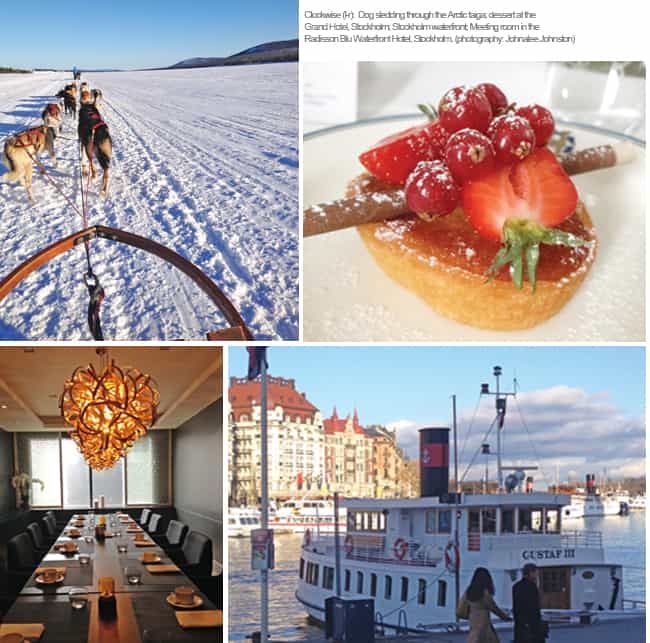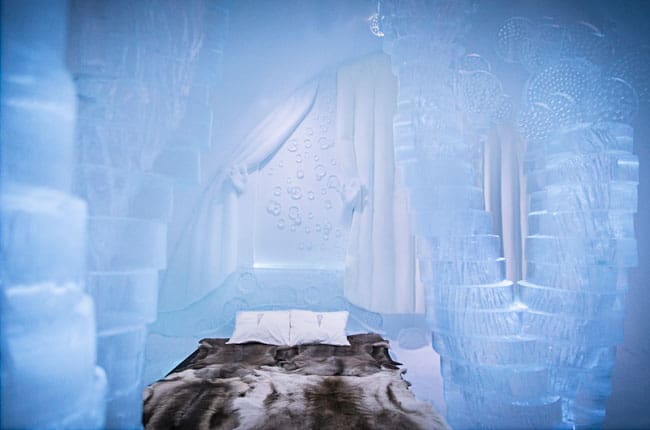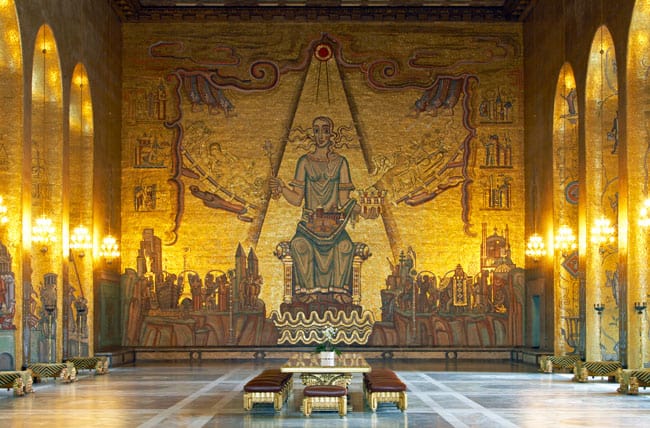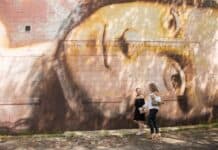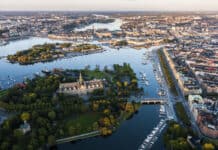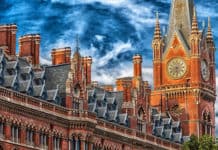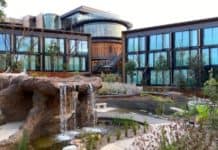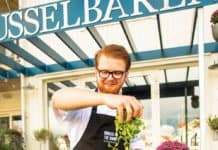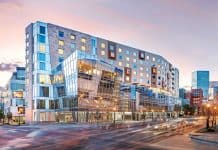“There’s always something in the ice.” Lena Kristrom, master sculptor of our workshop, leaves this statement a bit open-ended as any serious artist would.
We gaze into the blocks positioned on pedestals before us, chisels in hand, and it isn’t long before Kristrom’s talk of ancient ice fields and art nudges us into motion. It’s harder than it looks. The purity of the ice, completely free from air bubbles and sediments, seems perfect on its own. But a closer look reveals within it another world, and like many explorers who have come before us, intrigue quickly turns to conquer.
Every year since 1989, artists from around the world have faced a similar test at the Icehotel, located in the village of Jukkasjarvi—aptly named “meeting place”—in Northern Sweden. An annual harvest from the nearby Torne River borrows the several thousand tons of ice needed to create the 60,000-sf hotel anew each year. The walls, floors and ceilings of the hotel then become canvases for around 50 hand-selected artists of various disciplines. It’s a cross between Wonderland and Smurf Village, with ephemeral masterpieces tucked away beneath shimmering mounds of ice and snow.
“The ice that we use to build Icehotel is on loan to us from the Torne River,” CEO Monica Wollmen explains. “Thankfully, it’s still in its natural state, having never been used for industrial purpose, and its water is still so clean you can drink it straight from the river bank. We make something out of frozen water, and after a few months, it melts back to its former state, rejoining the river from where it came.”
We’re told photography excursions, snowmobile tours deep into the taiga (which include a surprising amount of pop-up places to eat along the way as we later discovered), taking to the ice on MINI Countryman Coopers and authentic Swedish Lapland experiences like kokkaffe (boiled coffee in the wild) are also offered by the hotel. But for now, it’s all about the ice, baby.
The wild river flows
Dog sleds dart across Arctic taiga, shimmering plateaus and frozen rivers to deliver us to the Icehotel from Kiruna airport. Midway, we stop for lunch in a traditional Sami lavvu, where hot lingonberry juice and reindeer stew are cooked over an open fire. The tipi-like structures show up periodically throughout the snow-dusted landscape, tracing the paths of indigenous Sami as they follow their reindeer herds. Later, we would experience the Sami culture firsthand at the Nutti Sámi Siida, a Sami-run lodge offering cultural experiences such as storytelling, joik (Sami folk songs), reindeer sledding and racing, and a northern lights tour into Abisko National Park.
After filling up and warming by the hearth, the howls of anticipation from our pack outside pull us back on track to the hotel. “There are more dogs in Jukkasjarvi than residents,” Gunnar Elinder, our musher during the 90-minute ride says. “And they love to run.” Dog sledding has been a way of life in Jukkasjarvi for hundreds of years. Meandering through the spruce, pines and occasional birch is like time traveling.
Finally arriving at the hotel, the view opens up into an infinite expanse of white as we scuttle across Torne River—it’s as if we’re donning the top of a frosty wedding cake.
Wollmen says most visitors find the hotel much larger than they had imagined—a kicksled tour of the grounds finds this on point.
In the end, there is the beginning
We’re first taken the warehouse that stores what appears to be thousands of 2-ton ice blocks harvested from the river March to April. Beneath the man-made grid and machinery used by the hotel’s crew to navigate the ice field, the wild river still flows.
We also explore 65 suites, including 19 individually-themed art suites, a church, main hall and reception area before hunkering down in the Icehotel bar for specialty cocktails based on art suite themes served “in the rocks,” or in ice glasses made on-site. Across the road is the Icehotel Restaurant, where a sprawling breakfast buffet starts the morning off right and dinners are heartily served on plates of crystal clear ice.
Positioned on the Torne in an 18th century schoolhouse-turned-restaurant is the Homestead. As delicious as the local delicacies are, the highlight of our meal is the impromptu arrival of the lovely Aurora Borealis, to which we all run outside to see, snowsuits dragging on the icy night path. Aurora’s magical green hair swooshes across the night sky in staccato, yet unpredictable, rhythms. For most of us, it’s a once in a lifetime experience. Also once in a lifetime, sleeping in -15 degree (F) temperatures.
“Aside from not having toilets and showers made of ice, I think the most common surprise groups have is that you actually have a pretty comfortable sleep in sub-zero degrees,” Wollmen says. My suite, fittingly called Polar Night, artfully conveys a confrontation between a pack of wolves and lone lynx under a full moon. The bed is covered in reindeer furs, and a polar-tested sleeping bag is quite warm with only mild layering on my part. An adjacent warm building—with a cozy lounge, bathrooms, showers and other modern conveniences—is open throughout the night, with keyed cubbies containing our luggage, outlets and a bench for changing, but few people need it. Warm accommodations are also nearby with single or double beds and all of the usual hotel amenities, including WiFi.
A 13,000-sf expansion powered entirely by solar is in the works for 2016. Like the Icehotel, the permanent sub-zero ice experience and its 20 suites, bar and gallery will have a life cycle whereby it changes guise every year.
Elegant, eclectic & extreme
A short flight to the south, Stockholm delivers its own brush with the extraordinary. Our experience began with the 19th century Grand Hotel, on the waterfront across from the Royal Palace and Old Town. The regal, yet modern and sophisticated hotel was inaugurated by King Oscar II, with the first Nobel Prize ceremony and banquet taking place in the Hall of Mirrors ballroom in 1901. The hotel currently draws celebrities, high-profile events and Nobel Laureates, who receive prizes in physics, chemistry, medicine and literature every December at the Stockholm Concert Hall. The Nobel Banquet and ball follows at City Hall.
The hotel offers 22 venues in all, each with its own theme and color palette—from lavish to laid back. Although the Grand Hotel’s culinary offerings are touted as some of the best around, we head to the Grill restaurant to experience the city’s quirky side.
Making your way through this restaurant is like being shrunken down and pasted into the middle of Lady Gaga’s personal scrapbook. It’s a hodgepodge of vintage furnishings, swanky sofas, mounted animal heads and scarcely clad mannequins spread over eight themed areas—from Moulin Rouge to the Orient Express. Everything on the menu has been grilled to some degree from local takes on surf and turf to grilled pineapple and coconut sorbet. After dinner, Magnus Lindbergh of Visit Sweden, which organized this trip, surprised us with a horse drawn carriage—complete with blankets and hot lingonberry juice—through the city back to the hotel. The ride is one of the more laid back tours of Stockholm. We’re told many groups also ask for rooftop, culinary and Viking tours, as well as kayaking tours through the archipelago. The Stockholm subway system is said to be the world’s longest art exhibit, with over 150 artists’ sculptures, mosaics, paintings, installations and engravings on display. Yes, there’s a tour for that too.
The Vasa Museum was one of our last encounters with the extraordinary. The museum was built around a 17th century Swedish warship that capsized within minutes of starting its maiden voyage. The meticulously preserved and elaborately carved ship is really a work of art and telltale of local traditions and superstitions. Huddled around the mighty ship in the Ship Hall, groups of up to 800 seated or 2,000 standing regularly partake in candlelit dinners with Nordic cuisine and guided tours around the ship. We dined on traditional Swedish meatballs and other local fare in the on-site restaurant, which can also be used for musical performances. Our guide suggests re-creating the Vasa’s maiden voyage through the archipelago and arriving by boat at the nearby jetty—only this time, with a much happier ending.
*Note: this writer does not partake in eating meat or riding reindeer. She does, however, partake in telling the tales of the destinations she visits with respect and authenticity.



